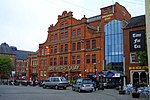Castle Cove, Weymouth
Beaches of DorsetCoves of DorsetGeography of Weymouth, DorsetJurassic CoastUse British English from March 2017

Castle Cove, also known as Sandsfoot Cove, is a small secluded sand beach to the west of Weymouth, in Dorset, southern England. It is in the parish of Wyke Regis, close to that village but closer to Sandsfoot Castle, one of Henry VIII's Device Forts, built around 1541 opposite its contemporary Portland Castle to protect Portland Roads (principally Weymouth Harbour). It is privately owned, but has remained open to the public and is a favourite spot for swimming, sailing, snorkelling and diving.Above the beach to one side is the Castle Cove Sailing Club; this began in a clifftop chalet in 1923; it moved to its larger base in 2002. As at 2014 it has over 450 members.
Excerpt from the Wikipedia article Castle Cove, Weymouth (License: CC BY-SA 3.0, Authors, Images).Castle Cove, Weymouth
Old Castle Road,
Geographical coordinates (GPS) Address Nearby Places Show on map
Geographical coordinates (GPS)
| Latitude | Longitude |
|---|---|
| N 50.597 ° | E -2.46 ° |
Address
Old Castle Road
Old Castle Road
DT4 8QG , Rodwell
England, United Kingdom
Open on Google Maps










